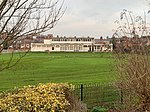Saffron Lane sports centre
Athletics (track and field) venues in EnglandAthletics in LeicestershireCycle racing in EnglandDefunct velodromes in the United KingdomSports venues in Leicester ... and 1 more
Use British English from July 2017

Saffron Lane sports centre is a large 8 lane (9 lane straight) 400 metre synthetic floodlight lit running track which includes a steeplechase water jump, in Leicester, England. It is home to the city's top two athletics clubs, the sprint and field specialists Leicester Coritanian A.C. and the middle and long distance specialists, OWLS AC Leicester. Other athletics squads train at the track, namely Leicester Walking Club, some members of University of Leicester athletics team among other local running clubs.
Excerpt from the Wikipedia article Saffron Lane sports centre (License: CC BY-SA 3.0, Authors, Images).Saffron Lane sports centre
Macaulay Street, Leicester Clarendon Park
Geographical coordinates (GPS) Address External links Nearby Places Show on map
Geographical coordinates (GPS)
| Latitude | Longitude |
|---|---|
| N 52.613583333333 ° | E -1.1354444444444 ° |
Address
Saffron Lane Stadium
Macaulay Street
LE2 7NJ Leicester, Clarendon Park
England, United Kingdom
Open on Google Maps







